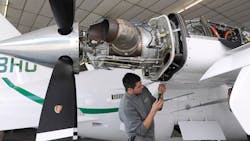A BIG Troubleshooting Secret: Principles Before Methods
Ralph Waldo Emerson once said:
"As to methods there may be a million and then some, but principles are few. The man who grasps principles can successfully select his own methods. The man who tries methods, ignoring principles, is sure to have trouble."
It's a pretty astute observation from a poet. That principles are far more important--and powerful, than methods. And when you consider that a lot of troubleshooting is conducted by trial of method, while principles are ignored, it's not too surprising that the path is often long and torturous, with missteps along the way.
This story from Simon Aguis, a Hydraulics Pro Club member from Malta, is a good illustration of what happens when principles are ignored, and when they are followed:
"My 12 year old son and I have been involved in karting for the last 14 months, mostly as enthusiasts, just racing for pleasure on Sunday mornings.
About a month ago, a guy at the track experienced starting and sudden stopping issues on his kid's 2-stroke kart engine. It seemed that no one could locate the cause of this intermittent problem. It had been persisting for 3 consecutive weekends and even those known at the track as the 'Professionals' in the field could not solve it. Electronic ignitions, the coil, and all sorts of other possibilities were offered up as the cause.
After several attempts resulted in a fail, I got the opportunity to troubleshoot the problem. Since I'm a novice in this field, and even though this wasn't a hydraulics problem, I decided to follow The Hydraulic Troubleshooting Handbook, step by step.
So first I applied Troubleshooting Principle (TP) #3, Check the Easy Things First. Logically, the easiest thing to check was the spark. So I asked if this had been done and was assured that the spark was OK, that several spark plugs had been tried, and that it would be useless to check it again.
So I moved on to apply TP#5, Never Take Anybody Else's Word For It, in conjunction with TP#4, Make Sure You Do Actually Check It. After removing the spark plug and cranking the engine, spark resulted OK but it didn't glow as it should. So I checked for any defective earth connections, and they were all good.
The next logical and easy thing to check was the spark plug cap. A deep look inside the cap with a torch, where the brass connector sits, showed a partial breakdown issue. I asked for any spare, but none was available. So I connected the high tension lead to the spark plug directly with the aid of a piece of tape. Started the kart and off it went. After several laps around the track it was clear the problem was solved.
It was unbelievable to me that a simple spark plug cap issue, that no one had managed to locate, was the culprit. But thanks to your Troubleshooting Handbook I now stand '10 feet tall' in the pits and am the go-to guy when problems arise.
Which means I now have a different problem - of limited karting attention time for my son, something for which I don't think you can help. Other than to follow TP#10, Backing Out, and return The Hydraulic Troubleshooting Handbook to sender. No way, FORGET IT mate, that's mine!"
Like Emerson said, there's probably a million troubleshooting methods. So if you insist on troubleshooting by method, without proper attention to the underlying principles, you're going to have a rough time.
The Hydraulic Troubleshooting Handbook outlines just 12 PRINCIPLES. And as the above story proves, nearly all of them apply when troubleshooting ANY system. Doesn't matter whether it's hydraulic, pneumatic, mechanical, electronic or even biological. The methods may vary, sure. But the troubleshooting principles are the SAME.
Bottom line: troubleshooting by method while ignoring principles can result in costly mistakes. And to discover six other costly mistakes you want to be sure to avoid with your hydraulic equipment, get "Six Costly Mistakes Most Hydraulics Users Make... And How You Can Avoid Them!" available for FREE download here.
About the Author
Brendan Casey Blog
Author
Brendan Casey is a war-weary and battle-scarred veteran of the hydraulics industry. He's the author of The Hydraulic Troubleshooting Handbook, Insider Secrets to Hydraulics, Preventing Hydraulic Failures, The Definitive Guide to Hydraulic Troubleshooting, The Hydraulic Breakdown Prevention Blueprint and co-author of Hydraulics Made Easy and Advanced Hydraulic Control. And when he's not writing about hydraulics or teaching it, Brendan is flat-out helping consulting clients from a diverse range of industries solve their hydraulic problems. To contact him visit his company's Website:
www.HydraulicSupermarket.com

Leaders relevant to this article:
